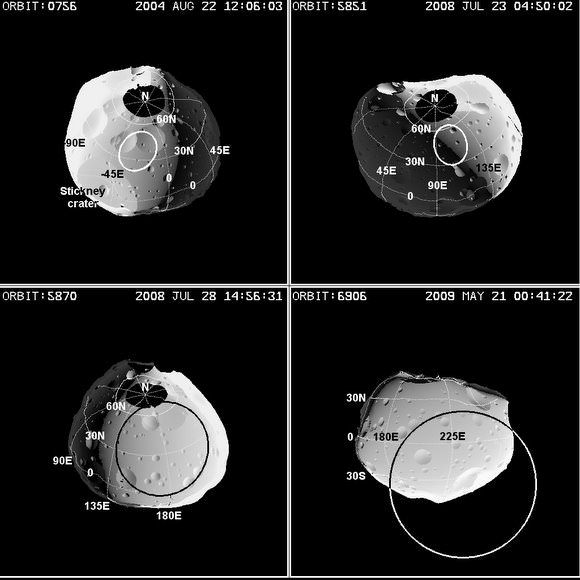[/caption]
Most theories on the formation of Phobos and its sister moon of Mars, Deimos, hold that the two moons did not form along with Mars, but were captured asteroids. However, new research indicates that Phobos formed relatively near its current location via re-accretion of material blasted into Mars’ orbit by some catastrophic event, such as a huge impact. This could be an event similar to how Earth’s moon formed. Thermal infrared spectra data from two Mars missions, ESA’s Mars Express and NASA’s Mars Global Surveyor have provided independent researchers similar new conclusions of how Phobos formed.
The origin of the two Martian satellites has been a long standing puzzle. Previous researchers have postulated that because of Phobos small size and highly cratered surface, as well as the fact that Mars is reasonably close to the asteroid belt, that Phobos was a captured asteroid. Recently, alternative scenarios suggested that both moons were formed in-situ by the re-accretion of rocky-debris blasted into Mars’s orbit after a large impact or by re-accretion of remnants of a former moon which was destroyed by Mars’s tidal force.
Today, Dr. Giuranna from the Istituto Nazionale di Astrofisica in Rome, Italy, and Dr. Rosenblatt from the Royal Observatory of Belgium presented their new findings at the European Planetary Science Congress in Rome, saying that the thermal data from the two spacecract, as well as the measurements of Phobos’ high porosity from the Mars Radio Science Experiment (MaRS) on board Mars Express, supports the re-accretion scenario.
“Understanding the composition of the Martian moons is the key to constrain these formation theories,” said Giuranna.

Previous observations of Phobos at visible and near-infrared wavelengths suggest the possible presence of carbonaceous chondritic meteorites, carbon-rich and likely from the early formation of the solar system, commonly associated with asteroids dominant in the middle part of the asteroid belt. This finding would support the early asteroid capture scenario. However recent thermal infrared observations from the Mars Express Planetary Fourier Spectrometer, show poor agreement with any class of chondritic meteorite. They instead argue in favor of the in-situ scenarios.
“We detected for the first time a type of mineral called phyllosilicates on the surface of Phobos, particularly in the areas northeast of Stickney, its largest impact crater,” said Giuranna. “This is very intriguing as it implies the interaction of silicate materials with liquid water on the parent body prior to incorporation into Phobos. Alternatively phyllosilicates may have formed in situ, but this would mean that Phobos required sufficient internal heating to enable liquid water to remain stable. More detailed mapping, in-situ measurements froma lander, or sample return would ideally help to settle this issue unambiguously.”
But other observations appear to match up with the types of minerals identified on the surface of Mars. From that data, Phobos appears more closely related to Mars than objects from other locations in the solar system.
“The asteroid capture scenarios also have difficulties in explaining the current near-circular and near-equatorial orbit of both Martian moons,” said Rosenblatt.
The MaRS instrument used the frequency variations of the radio-link between the spacecraft and the Earth-based tracking stations in order to precisely reconstruct the motion of the spacecraft when it is perturbed by the gravitational attraction of Phobos, and from this, the team was able provide most precise measurement of Phobos’ mass, with a precision of 0.3%.
Additionally, the team was able to give the best estimate yet of Phobos’s volume, with a density of 1.86±0.02 g/cm3.
“This number is significantly lower than the density of meteoritic material associated with asteroids. It implies a sponge-like structure with voids making up 25-45% in Phobos’ interior,” said Rosenblatt.
“High porosity is required in order to absorb the energy of the large impact that generated Stickney crater (the large crater on Phobos) without destroying the body,, said Giuranna. “In addition a highly porous interior of Phobos, as proposed by the MaRS team, supports the re-accretion formation scenarios”.
The researchers said a highly porous asteroid would have probably not survived if captured by Mars. Alternatively, such a highly porous Phobos can result from the re-accretion of rocky-blocks in Mars’ orbit. During re-accretion, the largest blocks re-accrete first because of their larger mass, forming a core with large boulders. Then, the smaller debris re-accrete but do not fill the gaps left between the large blocks because of the low self-gravity of the small body in formation. Finally, a relatively smooth surface masks the space of voids inside the body, which then can only be indirectly detected. Thus, a highly porous interior of Phobos, as proposed by the MaRS team, supports the re-accretion formation scenarios.
The researchers said they would like more data on Phobos to verify their findings, and the upcoming Russian Phobos-Grunt mission (Phobos Sample Return), scheduled for launch in 2011, will help to provide more understanding regarding the origin of Phobos.
Source: Europlanet Conference


I’m sorry, but those “voids” inside Phobos are obviously state rooms and hibernation quarters for the crew of Phobos — the spaceship….
How do I know? Richard Hoagland tells me so, therefore it *must* be true!!!
It’s all about the hyperdimensional physics, doncha know?
Hypothesis.
Rather well tested hypothesis thus far (fragmented moon, likely not captured, not chondrite, phyllosilicates, Mars composition, near-circular orbits, near-equatorial orbits). Our Moon has got one or two cousins!
And yet another point to add to the observations that Earth isn’t unique. A good Monday.
Yeah, that does jive well with the orbits being so neat. I would have figured a captured asteroid would have a much more elongated orbit, and the planes would likely be different.
I’m with ya, Gnat. The circular and equatorial orbits make a capture theory unlikely.